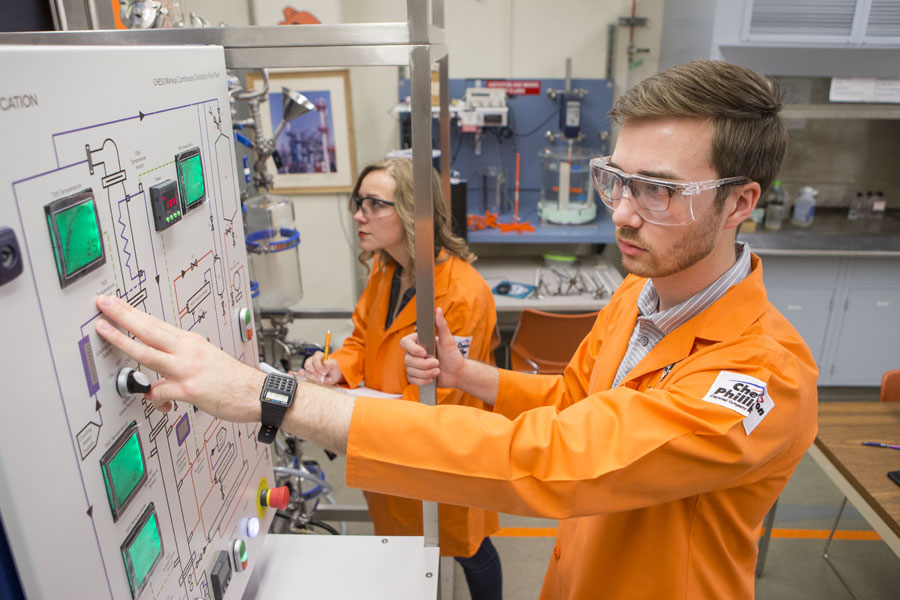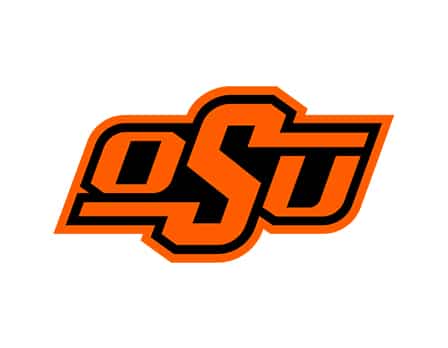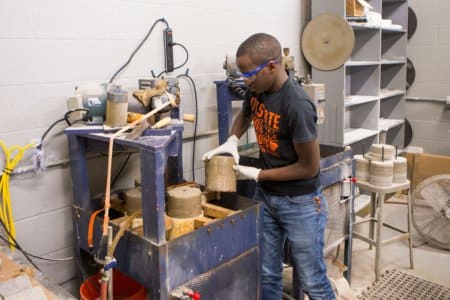There was one key reason why Rupom Bhattacherjee chose to pursue a PhD in Petroleum Engineering at Oklahoma State University (OKState): to reap the benefits of the Graduate Research Assistantship (GRA). “This financial backing is crucial, given the long-term commitment a PhD entails, and it significantly reduces the financial strain on students, making life much more manageable,” the Bangladeshi says.
Saeed Azizi, a Chemical Engineering doctoral candidate, focuses on produced water, the largest waste stream in the petroleum industry. His work on recovering valuable elements and investigating interfacial properties wouldn’t be possible without the support of the entire CEAT community and his “highly positive” experience thus far. His advisor is “incredibly supportive” and has “significantly contributed to his growth” as a researcher.
“He has taught me to identify problems, research solutions, and learn from mistakes, fostering a sense of confidence and independence,” says the student from Iran. “The broader faculty community is respectful and always willing to assist with both academic and personal matters. Collaborating with other graduate students, especially those in my lab, has been a rewarding experience.”
At the College of Engineering, Architecture, and Technology (CEAT), graduate degrees in Petroleum Engineering and Chemical Engineering take students’ education and careers to the next level. You can pursue an MS in Chemical Engineering, MS in Petroleum Engineering, PhD in Chemical Engineering, or PhD in Petroleum Engineering.
Whichever you opt for, you will receive support from OKState, the college, and the faculty in the department every step of the way. For greater financial security, all students admitted to Petroleum Engineering and Chemical Engineering are provided with either graduate research assistantships (GRAs) or graduate teaching assistantships (GTAs) with a 12-month stipend totalling US$30,000 annually. In addition to the monthly stipend, graduate student receive tuition waiver and subsidised health insurance.
After completing their first year, they can receive one out of multiple graduate fellowships available. This wide range of financial aid sets OKState apart from many other larger institutions, making it the ideal destination for Bhattacherjee to study Petroleum Engineering.
Ranked #15 in the US, Petroleum Engineering graduate programmes here offer a hands-on understanding of formation rock, applied mechanics, materials, fluid behaviour and application of their effects on reservoir, drilling and completion economics, and environmental sustainability. Thanks to strong links with local and national oil and gas companies in one of the most active exploration areas in the country, the MS and PhD in Petroleum Engineering provide you with the latest and most relevant engineering skills to address and solve real-world problems.
“The university’s emphasis on collaborative environments and its involvement in large federally funded projects have provided me with significant exposure and practical experience,” Bhattacherjee says. “These opportunities have honed my ability to work effectively in multidisciplinary teams and manage complex projects, which will be essential in my future career.”
The same is said for CEAT’s graduate degrees in Chemical Engineering. The MS and PhD in Chemical Engineering focus on conceiving and designing processes to produce, transform, and transport materials-beginning with experimentation in the laboratory followed by implementation of the technology.
“Graduate students publish their results in peer-reviewed journals to share their discoveries with others, and students are recognised for their contributions to the field through these publications,” says Professor Josh Ramsey, who teaches Chemical Engineering’s two-semester capstone course covering engineering economics, process design, and process safety. “Graduate students attend national and international conferences where they can present their latest findings and network with researchers from all over the world.”
Run by CEAT, both programmes emphasise energy transition and sustainability. Bhattacherjee developed a clay-coated microfluidic device that directly visualised rock-fluid interaction and fluid flow dynamics for his MS project. For his PhD research, he has built a CO2 storage decision support system for identifying suitable offshore storage locations in the Gulf of Mexico by integrating geological data, reservoir properties, and infrastructure accessibility to guide optimal site selection.
“Additionally, I am currently analysing saltwater injectivity data in Oklahoma to estimate formation permeability and CO2 injectivity in potential storage zones within the state,” he says. “Overall, my research bridges the gap between Petroleum Engineering and environmental sustainability, offering innovative solutions for efficient resource extraction and carbon management.”
Professor Zheyu Jiang, on the other hand, operates the Computational Laboratory for Advanced Manufacturing and Sustainability (CLAMS). Here, he tackles some of Chemical Engineering’s greatest challenges. These include industrial decarbonisation, agrochemical and pharmaceutical manufacturing, digital agriculture, and sustainability.
“The US manufacturing sector accounts for 20% of the country’s primary energy usage and greenhouse gas emissions. In particular, chemical and refining industries are responsible for nearly half of the manufacturing sector’s primary energy consumption and greenhouse gas emissions, most of which are used exclusively for process heating,” he says.
This prompted him and his team to develop new computational methodologies to enable secure information sharing among different stakeholders. By ensuring data privacy for real-world chemical plants and power systems, they can better coordinate their operations and maintenance to achieve holistic decarbonisation.
Other ongoing and notable research projects include carbon capture utilisation and sequestration (CCUS), renewable energy extraction methods like solar and geothermal, efficient water treatment technologies, and traditional and unconventional oil and gas production techniques. It is through projects like these that students find innovative solutions to today’s real-world problems, in addition to gaining practical experiences that will be useful in their careers.
Conducting research is not the only method both programmes use to prepare students to become future chemical and petroleum engineers. Monthly seminars and events, including field trips to industry sites, allow you to network with experts and build relationships that can boost your professional prospects.
It also helps that the teaching staff here give you their full attention at any given time. “While my students are self-motivated, I still like to meet with them in a casual setting to discuss research progress, answer questions, and share my personal experience in both industry and academia,” Professor Jiang says. “Through these conversations, students will recognise the real impact they are making.”
It’s easy to create impact when you’re learning from passionate faculty members. Not only is Professor Ramsey “extremely proud” of his OKState degree, but he also considers his role here as his “dream job.” So when he says the process design course “prepares students to hit the ground running and have a meaningful impact on the companies that hire them,” you know he means it.
PhD in Chemical Engineering student Ted Sperry is confident that his time here will set him up to hire people. As his long-term goal is starting his own business, the Riata Business Plan Competitions and the Creativity, Innovation, and Entrepreneurship programme have provided “valuable insights into the economic and entrepreneurial skills needed to launch a successful startup.”
In the shorter term, Sperry is set to start as a computational fluid dynamics research lead within a petrochemical company after graduation. His current research focuses on modelling airflow in human lungs with pharmaceutical inhalers for treating asthma and COPD. Computational and numerical methods are essential in many of his projects, both in the curriculum and research.
With all the skills, knowledge, and experience he’s gained here, Sperry is certain he can contribute to advancing technology and methodologies that can be applied across various industries. “The university provided access to various modelling tools, and the instruction and guidance from professors helped me develop the necessary skills and make the most of these resources, enabling me to excel in interviews and secure this position,” he says.
Follow Oklahoma State University on Facebook, Instagram, LinkedIn, Snapchat, and X.













